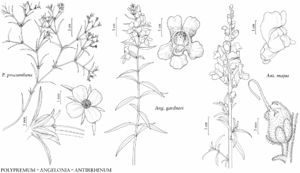Antirrhinum
Sp. Pl. 2: 612. 1753.
| Taxon | Illustrator ⠉ | |
|---|---|---|
 | Polypremum procumbens Angelonia gardneri Antirrhinum majus | Barbara Alongi Barbara Alongi Barbara Alongi |
Herbs [shrubs], perennial or annual. Stems erect, filiform, twining branches absent, glabrous or hairy. Leaves cauline, opposite proximally, alternate distally; petiole absent [present]; blade not fleshy, not leathery, margins entire. Inflorescences terminal [axillary], racemes [flowers solitary]; bracts present. Pedicels present; bracteoles absent [present]. Flowers bisexual; sepals 5, basally connate, calyx slightly bilaterally symmetric, cupulate, lobes ovate to lanceolate; corolla mauve, purple, red, yellow, or white, bilaterally symmetric, bilabiate and personate, tubular [funnelform], 25–45 mm, tube base gibbous abaxially, not spurred, lobes 5, abaxial 3, adaxial 2; stamens 4, basally adnate to corolla, didynamous, filaments glabrous, pollen-sacs 2 per filament; staminode 0 or 1, minute; ovary 2-locular, placentation axile; stigma capitate. Fruits capsules, 10–15 mm, locules unequal, dehiscence poricidal. Seeds 20–100, light-brown to brown, ovoid, reticulate, wings absent. x = 8.
Distribution
Introduced; Europe (Mediterranean region), also in temperate regions nearly worldwide
Discussion
Species 19 (1 in the flora).
Antirrhinum is sometimes treated as a larger genus including both the species of Mediterranean Europe and the species of western North America (D. M. Thompson 1988). Here, the North American species are treated in five genera, Howelliella, Mohavea, Neogaerrhinum, Pseudorontium, and Sairocarpus, believed to be more closely related to one another than to the European species (D. A. Sutton 1988). There is not yet enough evidence to resolve these relationships; DNA sequence data seem to indicate that the European and North American species are sister groups and that there are at least two groups of closely related species among the American taxa (R. K. Oyama and D. A. Baum 2004; M. Fernández-Mazuecos et al. 2013).
Antirrhinum is distinguished from the segregate genera by the radially symmetric seeds, terminal (versus oblique) styles, and flowers more than 2 cm.